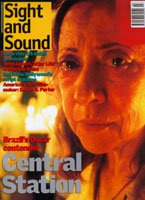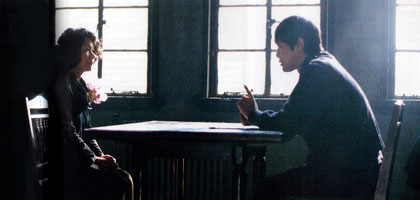
This Is Your Life

The dead negotiate their own heaven in Koreeda Hirokazu's After Life. Tony Rayns asks why we can't yet see it in the UK, and talks to the director
Koreeda Hirokazu's After Life began appearing at film festivals, including London's, in the latter months of 1998. Word soon got around that it was one of the few films of the year worth making an effort to see, and it provoked some interestingly strong responses. At the business-oriented Toronto Festival a bidding war broke out between Hollywood companies for the remake rights. At the more culture-oriented Vancouver Festival audiences seemed so much in tune with the film's humour and pathos viewers clustered around Koreeda afterwards wanting to touch him, as if he were some kind of secular saint. And at the Japanese premiere in the Tokyo Festival anyone arriving less than ten minutes before the scheduled start found it impossible to fight their way into a cinema already way past its legal capacity; by next day the Shibuya branches of Tower Records and HMV had sold out of copies of Koreeda's previous feature Maborosi (Maboroshi no Hikari, 1995).
Only one distributor has shown any interest in acquiring After Life for the UK, and - in the absence of the sale to BBC2 or C4 which would provide a financial safety-net - it cannot pay the advance the film's sales agent is looking for. So why is Sight and Sound running an article about a film which isn't likely to open in Britain any time soon? Because the film's non-appearance on UK screens does no credit to anyone in the business. Could this article function as a wake-up call to television buyers and distributors?
After Life (known in Japan as Wonderful Life) is easy to summarise but hard to describe. The narrative spans one week in the operations of a way-station (actually a former schoolhouse) between this life and another. Run on civil-service lines, the place has a small basic staff: chief of operations Nakamura and three male counsellors (Kawashima, Sugie and Mochizuki, the last assisted by the female trainee Satonaka Shiori). There is also a support staff of handymen, designers and technicians. The counsellors' job is to receive a fresh consignment of the newly deceased each Monday morning and to guide each dead person to the selection of his or her most blissful memory. When relived (with the help of a short film mocked up by the support staff), this memory becomes the person's individual heaven; all other memories of life on earth are erased when the person passes on to the next plane of existence. The deadline for choosing the memory is Wednesday evening; the staff then have the rest of the week to recreate, shoot and screen the memories... and to clear the decks for the following week's arrivals.
Koreeda is well aware that this fantasy has things in common with, for example, Lubitsch's Heaven Can Wait (1943), but his film doesn't play like any Hollywood entertainment, past or present. After Life does use the concept of a way-station in limbo to frame a number of emotive individual stories, just as a Hollywood film might, but it follows none of the rules of melodrama. Instead, it develops an extraordinary Chinese-box structure: successive layers of fiction and documentary are encased within each other so intricately that it becomes impossible to prise them apart. In one way, the film springs organically from the television documentaries Koreeda has been making (with unusual distinction) since the early 90s; in another, it represents a reaction against the control-freak aesthetic of the more purely fictional Maborosi. Either way, it's rooted in Koreeda's earlier work more deeply than in his feelings for mainstream cinema.
Koreeda traces his interest in memory back to the childhood experience of watching his grandfather succumb to Alzheimer's disease, gradually forgetting recent events, familiar places and members of the family. "As a child," he says, "I comprehended little of what I saw, but I remember thinking that people forgot everything when they died. I now understand how critical memories are to our identity, to a sense of self." It's an interest he has pursued across much of his work. The documentary August without Him (Kare no Inai Hachi-gatsu ga, 1994) centres on encounters with a dying man - Hirata Yutaka, the first man in Japan to 'come out' as HIV+ as a result of gay sexual contacts - and very movingly contrasts his increasingly erratic grasp of his own life with Koreeda's indelible memories of his and his crew's deepening involvement in that life during its last two years. More recently the documentary Without Memory (Kioku-ga Ushinawareta-toki, 1996) chronicles encounters with Sekine Hiroshi, a young father of two whose short-term memory was destroyed by a hospital blunder in 1992; Sekine remembers his life before 1992 but almost nothing since. Little sci-fi is as strange or disturbing. And Maborosi, of course, centres on a woman unable to shake her memories of an apparently happy husband who walked into an oncoming train.
The preparations for the production of After Life began with the videotaping of more than 500 interviews. Subjects, picked from the broadest possible social spectrum, were invited to describe the one memory they would choose to take with them to heaven. By his own account, this research helped Koreeda to understand better the process of remembering: the tendencies to fictionalise, embroider and evade. It also provided ten non-actors to join the film's cast. The first three chapters of the film - Monday, Tuesday and Wednesday - cut freely between actors working from Koreeda's script, actors working without a script and non-actors speaking autobiographically within the fictional context. Despite some overt editorialising in the cutting (for instance, Koreeda moves from an old man bragging about his experiences in the red-light district to a middle-aged woman who has been abused by men all her life), there's an overwhelming feeling of 'reality' about this part of the film. It's often hard to tell which are actors and which are not; nearly all the words and mannerisms feel acutely truthful.
As the film proceeds Koreeda gradually focuses attention on one of the subjects, a 70-year-old man named Watanabe (played by veteran actor Naito Taketoshi), and the counsellor Mochizuki (played by newcomer Arata) who has to guide him to the choice of a memory. Watanabe has trouble coming to terms with his "average" life and cannot identify any particularly happy moment. Mochizuki calls up reinforcements in the form of celestial surveillance videotapes, one for each of Watanabe's years, to help jog the old man's memory. This works for Watanabe, who slowly realises why his life had always felt so unfulfilling and comes to value the (arranged) marriage he had taken for granted; he eventually chooses a moment with his wife shortly before her death.
But the tapes have huge repercussions for Mochizuki, who realises that Watanabe's wife Kyoko was previously his own fiancée. This twist, which could obviously have been outrageously melodramatic in another context, prompts two crucial revelations. First, that Mochizuki is actually the same age as Watanabe; he died at the age of 20 in the war in the Philippines, and hasn't aged a day during his 50-odd years in limbo. Second, that Mochizuki, like the other staff members, is working in the way-station because he could not choose a memory for himself. His assistant Shiori, who has an unvoiced crush on him, tries to help him by digging Kyoko's chosen memory out of the archives. It turns out to be the memory of a charged, silent moment with Mochizuki. The realisation that he has been part of someone else's happiness transforms Mochizuki. He tells his chief he is finally ready to record and relive a memory of his own.
The closing stages of the film are resolutely fictional, but there's still a strong backwash from the earlier documentary elements, enhanced by the clean simplicity of Koreeda's mise en scène. The recourse to fiction allows Koreeda to get into areas beyond the reach of any documentary camera: an understanding of the reciprocity of emotion between individuals, a suggestion that subjective memories can be just as subject to reinterpretation as 'facts' are, and a sophisticated grasp of the ways fact and fiction co-exist in film - any film, including After Life itself.
